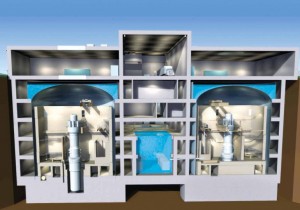
Jefferson City – Having a skilled union workforce that has already built, and safely operated, a nuclear power plant for the past 26 years is an essential factor in giving Missouri a leg up on creating a new budding industry building small modular reactors (“SMRs”) for sale around the world.
This new industry could generate at least 13,000 new construction and permanent follow-on jobs and create $37 billion in new economic impact in our state, should Missouri be selected for a pending Department of Energy $450 million matching funding grant to get the SMR project off the ground.
These were only some of the startling projections in a report released last week by James R. Moody, a leading policy voice in Missouri, and Missourians for a Balanced Energy Future (MBEF).
BUILD THEM HERE?
A modular reactor would be a 225-megawatt plant as compared to Ameren Missouri’s Callaway plant that produces 1,600 megawatts. Ameren proposes to build the first of five SMRs at the Callaway site. They have the permitting process under way.
However, the long-term hope is that Missouri is selected as the place to build these modular reactors for shipment to utilities across America and the world. The emerging markets of China, India and Africa are a potential market for hundreds, if not thousands, of these smaller reactors, the Labor Tribune was told.
The St. Louis Building & Construction Trades Council has endorsed the Ameren Missouri proposal and is supportive of Governor Jay Nixon’s efforts to have these small reactors built in Missouri. “We have the skilled workforce, in ample numbers, to produce these reactors and stand ready to work with any manufacturer,” said Jeff Aboussie, the council’s executive secretary-treasurer.
He pointed out that this is not only millions of manhours of work for union construction workers, but also thousands of new, permanent jobs in supporting industries like housing, restaurants and dozens of other support services after the plant is built.
“The 13,000 job figure could be conservative if we begin building a new nuclear power plant and then build and operate the SMR production facilities here to supply the world,” Aboussie added.
SKILLED WORKERS CRITICAL
“The issue of having a ready skilled workforce and incredible on-going training programs here is critical to Missouri’s application for a $450 million Department of Energy (DoE) matching grant to launch this program,” Irl Scissors, MBEF executive director, told the Labor Tribune.
Four applications are pending for the grant money. As many as two proposals could be accepted with a decision anticipated late this month or early September.
WORLD CENTER HERE
The Missouri application, considered one of the strongest, is backed financially by Ameren Missouri and Westinghouse Electric Corp. and has the pledged support from every utility in Missouri, major business groups, the Missouri AFL-CIO and all the state’s construction unions, “Another strong factor in Missouri’s bid,” Scissors added.
“Locating an SMR manufacturing facility in Missouri would be good for the Missouri economy, and a long-term positive for Missouri energy consumers. It would laso attract new technology and research, and make Missouri a center for export of the product throughout the United States and the world,” said Moody.
MISSOURI’S ADVANTAGES
The report outlines Missouri’s competitive advantage:
• Missouri’s well-trained (union) workforce.
• The unique geographic central location.
• Access to multi-modal transportation that provide the ideal environment for an SMR facility.
• State-of-the-art nuclear educational programs at the University of Missouri, Columbia, and the Missouri University of Science & Technology, Rolla.
“This report makes it clear that from an economic, geographic, educational and workforce related position, Missouri is best suited to serve as a global technology and manufacturing hub for SMRs,” said Scissors.
He pointed out that the experience of building and operating the Callaway County nuclear plant since 1984 shows the unique capabilities of Missouri’s workforces, to both build and operate the plant safely.
Unlike Callaway, which took almost ten years to build, SMR’s can be built in two years as modular units to be shipped, then reassembled on a site anywhere in the world.
“Our state has the scientific credibility and nuclear safety history needed for this opportunity, especially as it relates to our skilled workforce and academic credentials. We have some of the top nuclear engineering programs in the world located here in Missouri,” Scissors stressed.
‘AN OPPORTUNITY’
“We must continue to work together… this is an opportunity that Missouri cannot afford to pass up,” Scissors stressed.
The SMR investment funding also presents an opportunity for Missouri to become a global manufacturing powerhouse for this new technology. The demand for energy continues to grow, especially in countries like China and India.
According to the report, even conservative estimates state if Missouri becomes a global hub for SMR technology, it could provide 50 percent of the domestic market for SMR modules and 20 percent of the international market, which would generate billions in economic investment in this state.
The full Moody report can be found at www.moenergyfuture.org.
MBEF is a nonprofit, nonpartisan organization comprised of small and large businesses, chambers of commerce, labor unions, farmers, associations, trade groups and Missouri citizens who understand that securing Missouri’s affordable, reliable energy sources for tomorrow means making common sense decisions today.

